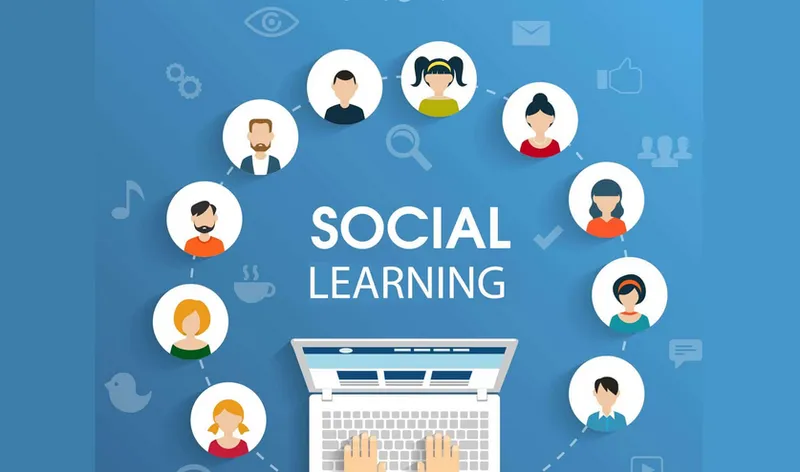

Why social and collaborative e-Learning is the future of learning?
Considering the social aspect of our everyday lives, today most of us learn by watching, listening and doing. We blend visual, auditory & kinaesthetic learning style as this help us gain better understanding of new concepts, to retain the knowledge, and to apply them to day-to-day challenges, be it at schools, coaching, work, or even at home.
Are you familiar with this concept of 70:20:10? It is a model for Learning & Development and it describes how the learning takes place. As per this,
- Our 70 percent of knowledge comes from learning & developing through experience
- Our 20 percent of knowledge comes from learning, interacting & developing through others
- Our 10 percent of knowledge comes from learning & developing through structured courses & programs
Hence, it doesn’t come as a surprise that today more & more education institutions are turning towards social learning in order to delivery interesting e-learning experience to the students. In fact, this concept is a lot more than being simply a buzzword, as it is being widely used by myriad of renowned education organization to nurture collaborative & social learning in the learning flow. This definitely will boost students’ performance as well as effectiveness of Learning & Development (L&D) activities.
Understanding the concept of Social & Collaborative e-Learning

Basically, it is an e-learning approach encouraging students to interact socially with the other students and also the instructor. Here the learners are working together so to widen their knowledge regarding a particular skill or subject. In the e-learning arena, it is usually done via message boards, live chats & instant messaging.
It is based on this vital principle that students are able to enhance their learning experience by interacting with others while also benefitting from the strengths of one another. In such kind of learning situations, it’s the students who are responsible for one another’s tasks & actions and this also boosts teamwork.
Why so much hoopla about it?
So, you must all agree to this that man by nature is a social animal and this is the reason social interactions happen to be so essential for our development at each point of our lives. After all, learning is mainly about interactions that we have across various stages of our lives, like we listen to what people are people, we talk to them, and then next we intend to consider or apply the insights bestowed upon us by that person, and vice-versa.
Hence, in case of educational organizations, being able to deliver majorly engaging and effective learning experiences that add on to success of an institution’s learning strategy is quite crucial to its bottom line. In fact, today it is no longer an option to deploy social learning concepts & technologies as part of the learning mix, as it has become a necessity.
Do you need proof?
Well, here go by these figures to expand your knowledge about this concept:
- It has been stated by semiconductor manufacturer, AMD that they succeeded in saving more than US$250,000 per year in web-based training production costs by shifting to social & collaborative e-learning.
- HBX, a Harvard Business School online education initiative experienced 85% increase in course completion upon introducing social & collaborative e-learning concept.
- Social e-learning approaches enjoy 75:1 ROI ratio as compared to formal web-based training.
- 82% of organizations that are using social e-learning tools intend to increase their usage in future.
You May Also Interest to know- E-Learning Application Development Cost and Features
How does Social & Collaborative e-Learning takes place?
So, as discussed above, social learning is basically learning with & from others, and you must be very clear about the concept by now. Now how does this happen? Well, it can happen either offline (during conferences, over coffee or during group discussions) or online (like over prominent social media platforms such as Twitter, LinkedIn & so on), which basically is e-learning.
What happens is that here their standard collaboration & communication features such as instant messaging, wikis, video chats, comments, posts, group discussion boards & so on, come useful. Besides, as an extension, a semi-structured approach can be brought as well so to encourage the collaborative learning concept. For this purpose virtual communities are built to encourage them to provide a forum for idea sharing, knowledge sharing & curating new inputs into the knowledge centre.
How social media is effective in social learning?

Well, it is basically social media which allow us to connect with people through its basic technology. It is used by us to stay connected with our friends or to network with business contacts and often it is used to share opinions & thoughts. However, its efficiency doesn’t end here as it is capable of a lot more, like leveraging it as a great tool for social & collaborative learning. What matters the most here is how we use it meaningfully to encourage idea exchange & knowledge sharing.
How social & collaborative e-learning can help people?
This kind of e-Learning gets the online learners engaged & interacting with their peers. It allows them to explore various viewpoints, to challenge the assumptions they had and ultimately make them a part of active online learning community. Hence, the benefits are tremendous, so here let’s get to know about a few:
- Enhances Online Learner Participation & Engagement
- It fosters a sense on Online Learning Community
- Helps the e-Learners in overcoming limiting beliefs
- Facilitates Peer-Based Feedback
- Helps in gaining a new perspective on the subject matter
- Offers mutually beneficial e-Learning experience
- Builds Teamwork skills
Does it have a flip-side?
Even though the jury is yet to determine the value and significance of social learning and the time taken by it to create an impact. However, no matter how much it is true that the process to go beyond individual learning to social & collaborative learning can take time, but its worthlessness is not doubtful at all.
Final Word: Without any doubt, social & collaborative e-learning is a sure-shot way to get the online learners engaged and leave an impact. In case, you wish to incorporate social & collaborative e-Learning activity into e-learning program, get the help of right IT service provider in your arena to get fruitful results.






